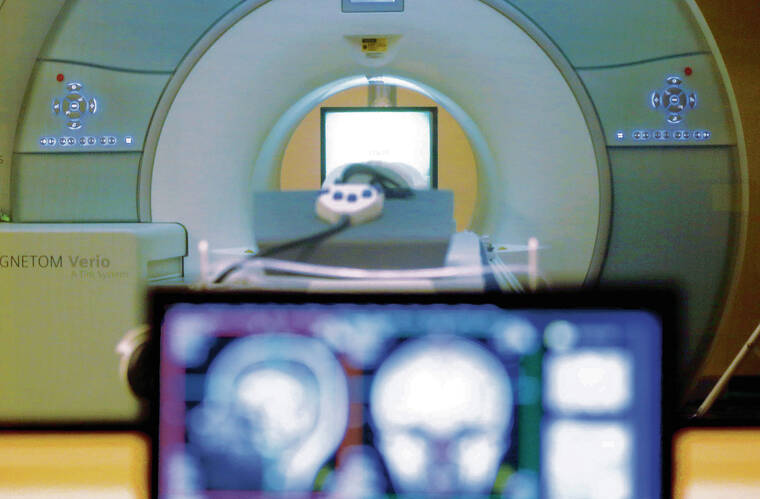Facts of the Matter: MRI machines seek hydrogen atoms to analyze soft tissue

ASSOCIATED PRESS / 2014
A brain-scanning MRI machine is seen at Carnegie Mellon University in Pittsburgh.
Before the development of magnetic resonance imaging, X-rays were the only way to image inside the body. But X-rays are too energetic and show hard structures such as bones while they penetrate connective tissue and organs that show only as ghostly images.
In essence, magnetic resonance tricks hydrogen atoms into revealing their location.
More than 60% of the human body is composed of hydrogen atoms. They are attached to carbon and oxygen atoms in the myriad of compounds that comprise the various types of tissue. MRI uses a property of hydrogen atoms called “spin” to distinguish differences between tissues such as muscle, fat and tendon.
There are three main components to an MRI machine: the primary coil, a radio frequency coil and gradient magnets.
The superconducting wires of the primary coil are kept cold enough to maintain their superconductivity by a bath of liquid helium at a temperature of 450 degrees Fahrenheit below zero. Without superconductors, the wires would have too much resistance and would not be able to carry enough electrical current to produce the necessary magnetic field, more than 20,000 times stronger than Earth’s magnetic field.
Normally, the single- proton nuclei of hydrogen atoms are randomly precessing on their axes in all different directions like spinning tops. Under the influence of the primary coil, the protons align their spin in one of two parallel directions pointing either toward the patient’s head or feet.
Don't miss out on what's happening!
Stay in touch with breaking news, as it happens, conveniently in your email inbox. It's FREE!
In principle, the strong magnetic field aligns the protons in equal numbers in both directions. In practice, because the process is random, a minute excess is always aligned in one direction or another. The excess is only a few atoms out of every million, but it is enough.
A tuned radio pulse from the RF coil forces the protons to alter the direction of their magnetization alignment ever so slightly. This “twisting” is the “resonance” part of the system. When this RF field is turned off, the protons return to the original magnetization alignment and emit a signal that the scanner can detect. The specific resonant frequency of the protons depends on the particular tissue being imaged and the strength of the primary magnetic field.
At the same time three smaller gradient magnets, about one-thousandth as strong as the primary, cycle off and on rapidly. The arrangement of these three gradient magnets is such that when they are turned on and off rapidly, they disrupt the main magnetic field on a local level. This allows targeting of a specific area, referred to as a “slice” as thin as a few millimeters.
The rapid on-off cycling of the gradient magnets produces the hammering noise that many patients find uncomfortable during a typical MRI scan, which can take up to 45 minutes.
The protons release the energy they absorbed from the RF pulses as they spring back to their natural alignment within the magnetic field when the RF pulse is turned off. The computer used to create the images on the monitor processes this signal.
Since the development of MRI scans from the first crude machines in the 1970s, the technology has become more efficient. This and the wider availability of MRI machines have aided health professionals in identifying soft-tissue diseases and injuries that would be impossible by any other means.





